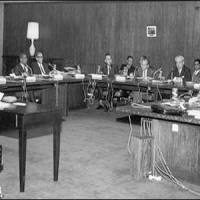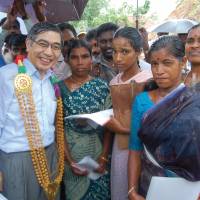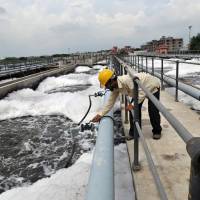Marking the landmark 50th annual meeting this year, the Asian Development Bank has come a long way in supporting Asia on its journey to being the world’s fastest-growing market.
The ADB was conceived in the early 1960s as an Asian-focused financial institution that would foster economic growth and cooperation in, what was at the time, one of the poorest regions in the world.
A resolution passed at the first Ministerial Conference on Asian Economic Cooperation held by the U.N. Economic Commission for Asia and the Far East in 1963 set that vision on its way to becoming a reality.
The Philippines capital of Manila was chosen to host the new institution, which opened on Dec. 19, 1966, with 31 members that came together to serve a predominantly agricultural region. Takeshi Watanabe was the ADB’s first president.
During the latter years of the 1960s, the ADB focused much of its assistance on food production and rural development.
When the world suffered its first oil shock, the ADB increased its support for energy projects, especially those promoting the development of domestic energy sources, in member countries.
Co-financing operations, which have the ADB managing the funds of other organizations, provide additional resources for ADB projects and programs. The ADB’s first bond issue in Asia — worth $16.7 million and issued in Japan — took place in 1970.
A major landmark was the establishment in 1974 of the Asian Development Fund to provide low-interest loans to the ADB’s poorest members.
By the end of the 1970s, some Asian economies had improved considerably and no longer needed the ADB’s assistance.
In the wake of the second oil crisis, the ADB continued its support to infrastructure development, particularly energy projects. The ADB also increased its support for social infrastructure, including projects involving microfinance, the environment, education, urban planning, health issues and assisting women and girls.
In 1982, the ADB opened its first field office — in Bangladesh — to bring operations closer to the people in need. Later in the 1980s, the ADB began working with nongovernment organizations to help disadvantaged groups.
In 1995, the ADB became the first multilateral organization to have a board-approved governance policy to ensure that development assistance fully benefits the poor. Policies on involuntary resettlement and indigenous people were also put in place.
ADB membership continued to expand with the addition of several Central Asian countries following the end of the Cold War.
In mid-1997, a severe financial crisis hit the region, setting back Asia’s economic gains. The ADB responded with projects and programs to strengthen financial sectors and create social safety nets for the poor. That year, the ADB approved its largest single loan — a $4 billion emergency loan to South Korea — and established the Asian Currency Crisis Support Facility to accelerate assistance.
In 1999 — recognizing that economic development was bypassing many people in the region — the ADB adopted poverty reduction as its overarching goal.
With the new century, the ADB focused on helping its member countries achieve the U.N.’s Millennium Development Goals (MDGs).
In 2003, the severe acute respiratory syndrome (SARS) epidemic hit the region, making it clear that fighting infectious diseases requires regional cooperation. The ADB began providing support at the national and regional levels to help countries more effectively respond to avian influenza and the growing threat of HIV/AIDS.
The ADB has also had to respond to unprecedented natural disasters, committing more than $850 million for recovery in the areas of India, Indonesia, Maldives and Sri Lanka that were hit by the December 2004 Asian tsunami. In addition, a $1 billion line of assistance to help victims of the October 2005 earthquake in Pakistan was set up.
In 2009, the ADB’s board of governors agreed to triple the ADB’s capital base from $55 billion to $165 billion, giving it more resources to respond to the global economic crisis.
Asia moved beyond the economic crisis to emerge as a new engine of global growth in 2010 when the region’s gross domestic product increased by 9 percent. This was more than double the global growth rate during the same period and well above the 5.9 percent rate recorded in the region in 2009.
While the speed and strength of its economic recovery surprised many, the region still faced daunting challenges and remained home to two-thirds of the world’s poor and a growing problem of inequality. This increasing gap between the rich and poor focused the ADB on the need to promote inclusive growth in the region.
In response to reforms initiated by the government of Myanmar, the ADB resumed operations in the country, and in April 2014, the bank established offices in Naypyitaw and Yangon.
In May 2014, plans were announced to combine the lending operations of the ADB’s two main funds, the Asian Development Fund and its ordinary capital resources. The merger will boost the ADB’s total annual lending and grant approvals to as high as $20 billion — 50 percent more than the previous level — when it took effect in January.
As the era of the MDGs draws to a close, the results have been mixed. While the ADB’s work has contributed to Asia and the Pacific slashing extreme poverty by more than half, the region is still home to 1.2 billion people who live on $3.10 a day or less and almost three-quarters of the world’s underweight children. About 600 million people have no access to electricity and 1.7 billion still lack adequate sanitation. A huge amount of work still must be done with the new U.N. Sustainable Development Goals as important guideposts.
Download the PDF of this 50th ADB annual meeting
The text excerpt from ADB website

 Click to enlarge
Click to enlarge


